| Carvedilol
improves contraction synchrony in the left ventricle in patients
with ischemic cardiomyopathy. This improvement in synchrony
translates into an improvement of contraction. This represents
an additional mechanism by which this beta-blocker exerts a
beneficial effect in these patients.
Intraventricular
conduction delays occur frequently in patients with heart
failure. These delays contribute to asynchronous contraction
patterns. The QRS width is typically used as a marker of cardiac
dyssynchrony. In the 6 published cardiac resynchronization
trials to date, researchers used QRS width as both a marker
of dyssynchrony and an inclusion criteria.
QRS Width as a Marker of
Dyssynchrony
Inclusion Criteria
in Completed CRT Trials
| |
QRS ms (mean) |
NYHA |
EF |
| MUSTIC |
>150 (176) |
III |
<35% |
| MUSTIC-AF |
>200 |
III |
<35% |
| MIRACLE |
≧130 |
III-IV |
≦35% |
| MIRACLE-ICD |
≧120 |
II-IV |
≦35% |
| PATH-CHF II |
≧120 |
II-III |
≦30% |
| COMPANION |
>120 + PR>150 |
III-IV |
≦35% |
|
The CHRISTMAS trial (Carvedilol Hibernation Reversible ISchaemia
Trial; MArker of Success) evaluated patients with systolic
dysfunction and heart failure due to ischemic heart disease
treated with carvedilol. Investigators designed this trial
to determine whether the presence or absence of hibernating
myocardium would predict improvement in left ventricular ejection
fraction.
Beta-blockade may have an effect on dyssynchrony
in heart failure patients. Dr. Dalle Mule and colleagues hypothesized
that improvement in left ventricular synchrony explained at
least part of the benefit of carvedilol in CHRISTMAS.
To determine this, they analyzed QRS duration,
left ventricular ejection fraction and intraventricular/interventricular
conduction delay. The analysis included 164 patients from
the CHRISTMAS study. All these patients underwent radionuclide
ventriculography at randomization and again at the end of
the maintenance phase of treatment with carvedilol or placebo.
The analysis included 81 patients in the carvedilol
group and 83 patients in the placebo group. Most were males
(mean age 63 years), and most were NYHA functional class II.
More than 80% had a previous myocardial infarction and almost
half had a previous revascularization procedure.
Patient Characteristics
| |
Placebo
(n = 83) |
Carvedilol
(n = 81) |
| Age (years) |
63 |
63 |
| Males (%) |
92 |
93 |
| NYHA class I (%) |
12 |
10 |
| NYHA class II (%) |
59 |
63 |
| NYHA class III (%) |
29 |
27 |
| Mean LVEF (%) |
28 |
30 |
| Previous MI (%) |
88 |
84 |
| Previous revascularization
(%) |
51 |
47 |
| Diuretics (%) |
86 |
74 |
| ACE-inhibitors (%) |
88 |
88 |
| Hibernators (%) |
64 |
59 |
|
Interventricular Dyssynchrony
In the carvedilol-treated patients, the degree of interventricular
dyssynchrony significantly improved between baseline and the
end of the study. Degree of dyssynchrony did not change in
the placebo-treated patients. At the final examination, the
degree of interventricular dyssynchrony was significantly
less apparent in the carvedilol group compared with the placebo
group.
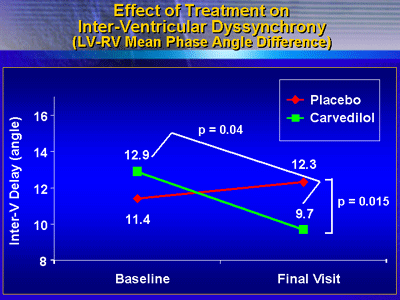
Intraventricular Dyssynchrony
The degree of intraventricular dyssynchrony
for the left ventricle improved significantly in carvedilol-treated
patients, but did not change for placebo-treated patients.
At the final visit, intraventricular dyssynchrony was less
evident in the carvedilol group than in the placebo group.
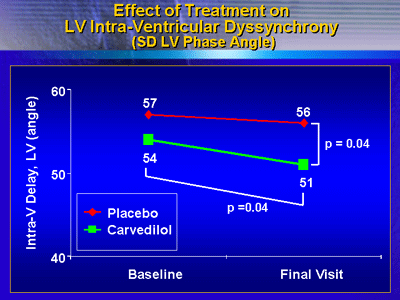
This is an example of a patient who received
carvedilol. The yellow color on the apex of the left ventricle
is an area of dyssynchrony (left image). The bell-shaped histograms
result from delayed contraction. After treatment the area
of dyssynchrony is much less (right image).
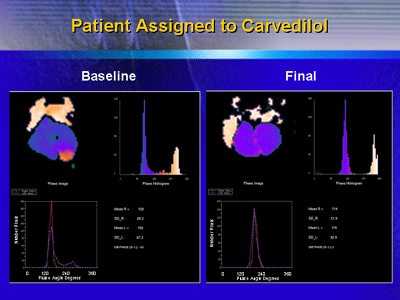
By contrast, this is an area of dyssynchrony in a placebo-treated
patient. Dyssynchrony is evident at entry and persists at
the final exam.
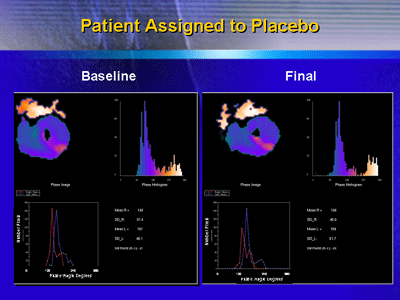
QRS Duration
In the overall population, QRS duration was 107 ms at baseline
and 110 ms at final examination (p=0.16) and was similar in
carvedilol versus placebo-treated patients. There was no change
in QRS duration from baseline to final examination in either
the carvedilol or placebo groups. Both at baseline and final
exam, there was no significant correlation between QRS duration
and degree of interventricular/intraventricular dyssynchrony.
This suggests even patients with a lesser degree of QRS prolongation
may experience dyssynchrony, Dr. Dalle Mule said.
Change in Ejection Fraction
As expected, the left ventricular ejection fraction increased
significantly in the carvedilol group, but not in the placebo
group. There was a closer relationship between ejection fraction
and left intraventricular dyssynchrony (right), rather than
interventricular dyssynchrony (left).
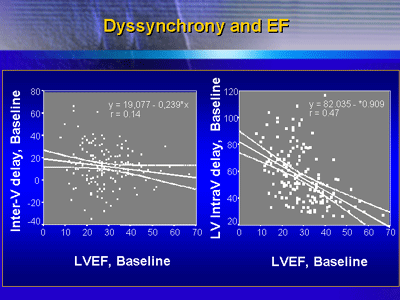
Improvement in Mechanical Function
Most patients who had an improvement in left
ventricular ejection fraction also had an improvement in left
ventricular intraventricular dyssynchrony (36 of 43 patients,
84%). Investigators noted that there was a deterioration in
those who did not have an improvement in ejection fraction.
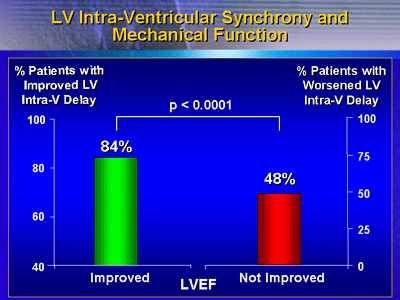
This study shows that dyssynchrony of ventricle contraction
is common in patients with ischemic cardiomyopathy. Moreover,
treatment with carvedilol improves contractile synchrony.
The beneficial effects of carvedilol were independent of baseline
QRS duration. This improvement in synchrony translates into
an improvement of contraction.
Based on these results, Dr. Dalle Mule
said improvement in ventricle contraction synchrony is an
additional mechanism by which carvedilol provides a benefit
in patients with ischemic cardiomyopathy.
|